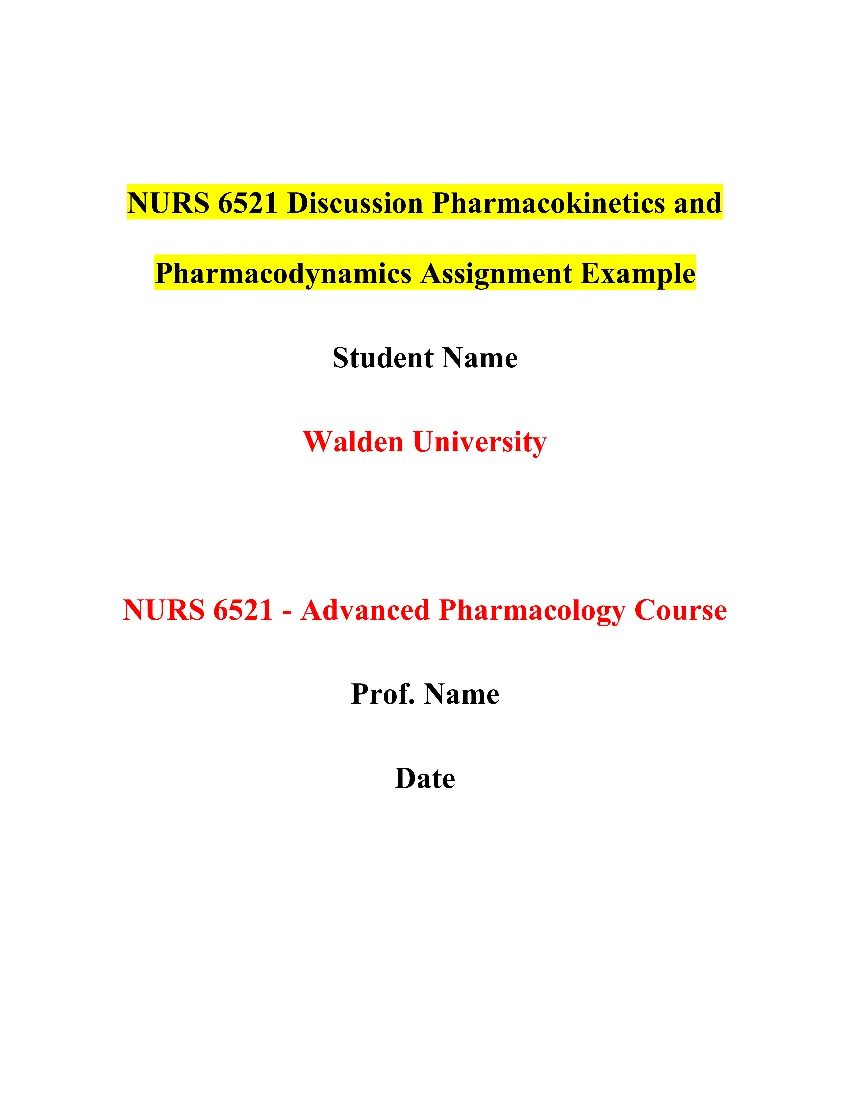NU 607 Phenomenon of Interest (POI) Topic Selection Discussion Example
 NU 607 Nursing Phenomenon of Interest (POI) Assignment Brief
NU 607 Nursing Phenomenon of Interest (POI) Assignment Brief
Assignment Title: Comprehensive Exploration of a Nursing Phenomenon of Interest (POI): Holistic Understanding and Application in Advanced Nursing Practice
Assignment Overview:
In this assignment, your objective is to conduct a comprehensive exploration of a Nursing Phenomenon of Interest (POI) of your choosing. The aim is to develop a thorough understanding of the chosen POI, explore relevant philosophical viewpoints, and apply Carper’s patterns of knowing in the context of advanced nursing practice. This assignment requires a scholarly approach, integrating theoretical concepts with practical implications for nursing.
The Student’s Role:
As the student, your responsibility is to select a Nursing Phenomenon of Interest that aligns with your advanced nursing specialty focus. Conduct a thorough literature review to support your analysis and integrate theoretical concepts. Demonstrate a critical understanding of the philosophical underpinnings in nursing, showcasing the application of both analytical and continental perspectives. Apply Carper’s patterns of knowing to illustrate how different forms of knowledge contribute to a holistic approach in nursing practice. Ensure that your writing reflects graduate-level scholarship, adhering to formal, scholarly writing standards, and meet the specified length requirements.
Detailed Assignment Instructions: Module 1-B Paper: POI & Philosophic View
Criteria
Introduction and Thesis Statement
- Introduce the problem/Phenomenon of Interest (POI) in one (1) introductory paragraph.
- Conclude the introductory paragraph with a direct thesis statement that informs the reader of the purpose or the primary objective of the paper.
Phenomenon of Interest (POI)
- Describe your approved POI, including the setting and population.
- Describe the significance of your POI to your advanced specialty focus (Nurse Practitioner, Executive Nursing Administration, Nursing Informatics, etc.), and population
- Discuss the impact of the POI on the overall U.S. healthcare system and support your discussion with relevant statistical data (clinical and financial).
- Include at least three (3) current peer-reviewed references in addition to any textbooks.
Philosophic Viewpoints
- Describe the differences between the Analytical and Continential philosophical viewpoints and identify your preferred philosophical view
- Discuss how your preferred philosophical view influences the type of information (data) you evaluate regarding your chosen POI and provide examples.
- Describe the value of information (data) represented by your alternative or opposing philosophic viewpoint in evaluating your chosen POI
- Describe the advantages of incorporating both the Analytical and Continental philosophical views in your advanced nursing practice, and provide an example.
- Include at least three (3) peer reviewed references in addition to any textbooks. Classic references based on theory may be older than five years.
Ways of Knowing
- Introduce the fundamental patterns of knowing identified by Carper (1978).
- Describe how you would apply each of the four patterns of knowing to your chosen POI, and provide examples of each.
- Support your discussion with at least two (2) peer-reviewed references, citing primary sources. Classic literature may be older than five years
Conclusion
- Summarize the major points of the paper in one (1) paragraph.
- No new information or new references should be included in this section.
Graduate Level Scholarship
Demonstrate Graduate Level Scholarship
- Formal, scholarly writing style with no first-person language.
- Writing should be clear and concise and free of grammatical and spelling errors
- Organize work by headings
- Writing should be free of APA 7th errors, including citations and references.
- Turnitin similarity score supports that the paper is your original work.
- College of Nursing approved format for the title page.
- A minimum of eight (8) peer-reviewed references (excluding textbooks).
- Paper not to exceed five (5) pages (excluding title page, reference page, and any appendices).
- Follow all assignment instructions, and do not use direct quotes unless providing a brief definition.
- Additional deductions may apply for late submissions, plagiarism, or lack of scholarship and professionalism.
NU 607 Phenomenon of Interest (POI) Topic Selection Discussion Example
Introduction and Thesis Statement
Despite extensive efforts to promote safe sex practices and disease prevention, the United States continues to face a rising tide of sexually transmitted infections (STIs) (Henderson et al., 2020). In 2018, the Center for Disease Control (CDC) reported that 1 in 5 individuals was diagnosed with an STI, amounting to approximately 68 million infections (CDC, 2022). The implications of STIs extend beyond individual health, leading to complications such as infertility, chronic diseases, cancer, and even mortality, incurring a substantial annual cost of 16 billion dollars in direct medical expenses (Barrow et al., 2020). This paper aims to explore the phenomenon of interest (POI) related to STIs, specifically focusing on the population of adolescents and young adults in Mississippi. The overarching goal is to understand the significance of this POI, its impact on the U.S. healthcare system, and to analyze it through different philosophical viewpoints and ways of knowing in the context of advanced nursing practice.
Phenomenon of Interest (POI)
Sexually transmitted infections (STIs) represent a pervasive and pressing public health concern, particularly among young populations. The prevalence of these infections, as underscored by the CDC, demands a nuanced examination, and this study focuses on a specific and vulnerable demographic—adolescent and young women at high risk of contracting STIs. This emphasis is contextualized within the state of Mississippi, which consistently reports the highest number of STIs in the country. The geographic specificity is not incidental but driven by the urgent need to address localized challenges and tailor interventions to the unique dynamics of this region.
Adolescents and young adults face a unique set of challenges when it comes to sexual health. CDC statistics paint a vivid picture, revealing a disconcerting 61% prevalence of Chlamydia among individuals aged 15 to 24, indicating a significant vulnerability within this age group (Kantor & Lindberg, 2020). These young individuals are not only grappling with the physical ramifications of STIs but also contending with the potential consequences on their emotional and mental well-being. The ripple effects extend further, impacting their educational pursuits, future fertility, and overall quality of life.
As a nurse practitioner specializing in sexual health, the commitment to addressing this POI goes beyond professional obligations—it is a moral imperative. The focus on providing culturally tailored education is not a one-size-fits-all approach but a recognition of the diverse cultural, social, and economic contexts that shape individuals’ perspectives and behaviors regarding sexual health (Goldfarb & Lieberman, 2021). The aim is not merely to disseminate information but to empower these vulnerable populations, fostering informed decision-making and agency in managing their sexual health.
Furthermore, the geographic focus on Mississippi adds a layer of complexity. Beyond the raw numbers, understanding the specific socio-cultural factors influencing sexual health practices in this region is paramount. High STI rates may be symptomatic of broader systemic issues such as limited access to comprehensive sex education, healthcare disparities, and socio-economic challenges. Therefore, a thorough exploration of the POI in Mississippi necessitates an examination of these underlying determinants, aiming to uncover the root causes of the high prevalence of STIs.
The impact of STIs on the U.S. healthcare system is both profound and far-reaching. The sheer magnitude of new infections reported by the CDC in 2018—28 million—underscores the urgency of developing effective prevention strategies (Shannon & Klausner, 2018). The financial burden, with costs per case ranging from $756 to $9973 for different STIs, poses not only a strain on the healthcare system but also a considerable economic burden on individuals and communities (Kantor & Lindberg, 2020). Beyond the direct medical expenses, the indirect costs, including productivity losses and the long-term implications of untreated STIs, compound the challenge.
To comprehensively address this POI, an understanding of its multifaceted nature is imperative. It goes beyond clinical manifestations and statistical figures—it involves delving into the social determinants, cultural nuances, and systemic factors that contribute to the high prevalence of STIs among adolescents and young adults in Mississippi. This exploration is not only an academic exercise but a crucial step in formulating targeted and effective interventions that address the root causes of the issue. Thus, the POI becomes a dynamic and evolving landscape, shaped by the interplay of individual behaviors, cultural contexts, and systemic factors, demanding a holistic and context-specific approach to intervention.
Philosophic Viewpoints
In navigating the complexities of addressing sexually transmitted infections (STIs) among adolescents and young women in Mississippi, a critical consideration is the philosophical underpinning that guides the approach to healthcare delivery. Analytical philosophy, distinguished by its emphasis on clarity, formal logic, and evidence-based thinking, contrasts with continental philosophy, which integrates various schools of thought and emphasizes subjective experiences. Both philosophical viewpoints have their merits, and their integration offers a comprehensive framework for understanding and addressing the multifaceted nature of the Phenomenon of Interest (POI).
Analytical philosophy, rooted in empirical data and scientific research, provides a structured and logical approach to decision-making in healthcare. In the context of STI prevention, analytical philosophy encourages the rigorous evaluation of interventions through evidence-based practices. This includes scrutinizing the outcomes of randomized controlled trials (RCTs), statistical analyses, and epidemiological data to inform clinical decision-making (Jemmott et al., 2018). Analytical philosophy’s commitment to logical reasoning ensures that interventions are grounded in robust evidence, fostering confidence in the efficacy of preventive measures.
On the other hand, continental philosophy, with its emphasis on subjective experiences and holistic approaches to patient care, enriches the understanding of STI prevention beyond mere empirical data. In this context, continental philosophy recognizes that the lived experiences of individuals and communities play a pivotal role in shaping health outcomes. Understanding the cultural, social, and contextual factors that contribute to the prevalence of STIs allows for a more nuanced and tailored approach to intervention (Kantor & Lindberg, 2020). Continental philosophy, particularly when applied to nursing, emphasizes a holistic care model that encompasses the physical, emotional, cultural, and spiritual dimensions of health (Goldfarb & Lieberman, 2021). This approach recognizes patients not merely as subjects of statistical analysis but as individuals with unique narratives and needs.
As a nurse practitioner specializing in sexual health, the preference for continental philosophy is driven by its inherent alignment with patient-centered care. In addressing the POI of STIs among adolescents and young women in Mississippi, continental philosophy allows for a more profound exploration of the cultural and social determinants influencing sexual health practices. By recognizing the subjective experiences of the target population, this philosophical perspective facilitates the development of interventions that resonate with the diverse backgrounds and perspectives within the community.
For instance, a continental philosophical approach may involve engaging in qualitative research methods such as interviews and focus groups to understand the subjective factors contributing to the prevalence and spread of STIs. This could include exploring cultural norms, social stigmas, and individual experiences related to sexual health. By acknowledging these subjective aspects, interventions can be designed to address not only the clinical manifestations of STIs but also the broader socio-cultural factors that contribute to their persistence.
The integration of both analytical and continental viewpoints in nursing practice represents a synergistic approach that capitalizes on the strengths of each philosophy. In the realm of STI prevention, this integration allows for a holistic understanding that incorporates empirical evidence while also recognizing the importance of subjective experiences in shaping health outcomes. Nurses adopting this integrated approach can provide evidence-based recommendations grounded in analytical philosophy while simultaneously acknowledging and addressing the diverse needs of patients, as encouraged by continental philosophy (Barrow et al., 2020).
An illustrative example of this integration involves the development of STI prevention programs that incorporate both evidence-based practices and culturally sensitive approaches. While analytical philosophy guides the selection of interventions based on empirical evidence of effectiveness, continental philosophy ensures that these interventions are adapted to the unique cultural and contextual aspects of the population in question. This integration not only enhances the relevance and acceptability of interventions but also fosters a more comprehensive and patient-centered approach to STI prevention.
Ways of Knowing
Carper’s four patterns of knowing—empirical, personal, aesthetic, and ethical—constitute a foundational framework for understanding how knowledge is generated and applied in nursing practice. In the context of addressing sexually transmitted infections (STIs) among adolescents and young women in Mississippi, the application of these ways of knowing is pivotal in crafting a comprehensive and patient-centered approach to prevention and care.
- Empirical Knowing: At the core of evidence-based practice, empirical knowing involves the use of natural science, observation, and evidence to inform decision-making (Thorne, 2020). In the context of the chosen POI, empirical knowing translates into a reliance on rigorous scientific research and evidence to guide interventions. This may involve a thorough review of existing literature, including randomized controlled trials (RCTs) and epidemiological studies, to understand the effectiveness of various STI prevention strategies (Jemmott et al., 2018). Applying empirical knowing ensures that interventions are grounded in the best available evidence, enhancing their likelihood of success.
- Personal Knowing: Personal knowing, rooted in self-reflection and personal experiences, emphasizes the importance of the nurse’s own experiences in shaping their understanding of patient needs (Thorne, 2020). In the context of STI prevention, personal knowing encourages nurses to reflect on their own biases, assumptions, and cultural perspectives that may influence their interactions with patients. This self-awareness is crucial in providing culturally competent care and acknowledging the diverse backgrounds and experiences of individuals affected by STIs.
- Aesthetic Knowing: Aesthetic knowing, characterized by an appreciation for creativity, beauty, and art, plays a unique role in the context of STI prevention (Thorne, 2020). In designing educational materials, awareness campaigns, and interventions, nurses can leverage aesthetic knowing to create visually appealing and culturally relevant resources. This may involve the creative use of multimedia, art, and design to convey information in a way that resonates with the target population, fostering increased engagement and understanding (Jemmott et al., 2018).
- Ethical Knowing: Ethical knowing centers on considerations of morality and ethical decision-making in nursing practice (Thorne, 2020). In the context of STI prevention, ethical knowing ensures that interventions prioritize principles of justice, equity, and respect for individuals’ autonomy. This includes providing unbiased and equal educational resources to patients of diverse backgrounds, addressing potential stigmas associated with STIs, and upholding the confidentiality and privacy of those seeking care (Barrow et al., 2020). By applying ethical knowing, nurses contribute to the development of interventions that are not only effective but also ethically sound.
Applying these ways of knowing in a holistic manner allows nurses to navigate the complexities of STI prevention. For instance, empirical knowing guides the selection of evidence-based interventions, personal knowing ensures that care is individualized and culturally sensitive, aesthetic knowing enhances the appeal and accessibility of educational materials, and ethical knowing upholds the principles of justice and respect. This integrative approach acknowledges that successful STI prevention requires more than just clinical interventions—it necessitates an understanding of the individual, cultural, and ethical dimensions that influence health behaviors.
In practical terms, a nurse utilizing these ways of knowing might engage in ongoing self-reflection to identify and address personal biases, continuously update their knowledge base through empirical research, collaborate with creative professionals to design engaging educational materials, and consistently apply ethical principles in all aspects of patient care. This holistic approach aligns with the overarching goal of addressing the unique needs of adolescents and young women in Mississippi affected by STIs, ensuring that interventions are not only effective but also respectful of their diverse experiences and backgrounds.
Conclusion
In essence, the exploration of sexually transmitted infections (STIs) among adolescents and young women in Mississippi reveals a complex interplay of clinical, cultural, and systemic factors. As a nurse practitioner specializing in sexual health, the commitment to addressing this Phenomenon of Interest (POI) goes beyond professional duty—it is a moral obligation to empower vulnerable populations. The geographic focus on Mississippi underscores the need for context-specific interventions, acknowledging the unique socio-cultural determinants influencing sexual health practices. The integration of analytical and continental philosophies provides a robust framework for comprehending and addressing STIs. Analytical philosophy’s evidence-based rigor complements continental philosophy’s emphasis on subjective experiences, creating a synergy that enriches the understanding of the POI. This philosophical integration is not a theoretical exercise but a practical approach to developing interventions that are both evidence-based and culturally sensitive. Carper’s four patterns of knowing further enhance this comprehensive approach. By applying empirical, personal, aesthetic, and ethical ways of knowing, nurses can navigate the intricacies of STI prevention. This holistic understanding recognizes the individuality of patients, fosters creativity in educational initiatives, and upholds ethical principles in care delivery. As nurses, our role in addressing STIs extends beyond clinical interventions—it involves advocacy, education, and a commitment to dismantling barriers. The POI is not static; it evolves with the changing landscape of healthcare and societal norms. Therefore, the commitment to ongoing research, self-reflection, and collaboration remains imperative. In essence, the study of STIs in Mississippi is a call to action. It calls for evidence-based interventions, culturally sensitive approaches, and a recognition of the ethical imperatives guiding healthcare. By embracing this holistic perspective, nurses contribute not only to the prevention of STIs but also to the broader goal of improving sexual health outcomes and fostering a healthcare landscape that prioritizes the well-being of all individuals, regardless of their background or circumstances.
Take Your Academic Potential to the Next Level with ReliablePapers.com: Your Top Nursing Paper Writing Ally
Are you feeling overwhelmed by the complexity of your nursing assignment? Don’t stress! At ReliablePapers.com, we pride ourselves on being the best nursing paper writing service, ready to assist you on your academic journey. The provided sample on [NU 607 Nursing Phenomenon of Interest (POI) Topic Selection Discussion Example] is just a glimpse of what our expert nursing essay writers can do for you.
Why Choose Us?
We understand that some topics can be tougher than others, and that’s where our expertise comes in. If the sample provided isn’t sufficient for your unique assignment, our pro writers can craft an original and customized nursing paper that guarantees you the best grades possible. No more worries about plagiarism – we deliver authenticity.
Worried About the Cost?
Our online nursing papers are available at very affordable prices, ensuring accessibility to all college students. We offer reliable research paper help, term paper assistance, and coursework writing help, all tailored to meet your specific needs.
Still Hesitant?
Whether you’re dealing with a complex topic, facing a tight deadline, or seeking guidance on write your phenomenon of interest nursing assignment, ReliablePapers.com is your go-to place to buy nursing papers. Our writers will provide you with an outstanding nursing essay paper written from scratch, addressing any topic, meeting any deadline, and adhering to all your instructions.
Save Time for What Truly Matters!
Seek the help of professional essay writers from ReliablePapers.com. Let ReliablePapers.com be your academic partner, helping you succeed one paper at a time!
Hire an Expert Paper Writer on Any Subject, Any Topic, Any Deadline! Submit your paper instructions by placing your order here to get started!


 Assignment Brief: NU 607 Nursing Concept Analysis Paper on Phenomenon of Interest
Assignment Brief: NU 607 Nursing Concept Analysis Paper on Phenomenon of Interest Assignment Brief: NU 607 Concept Map of Praxis Framework Nursing
Assignment Brief: NU 607 Concept Map of Praxis Framework Nursing Assignment Brief: Comparative Analysis Paper of the Healthcare System in the United States
Assignment Brief: Comparative Analysis Paper of the Healthcare System in the United States In the world of academic writing, creating an outstanding essay goes beyond just finding good research and making strong points. It’s about using words in a smart and clear way. Imagine it like a puzzle – and the most important piece of that puzzle is grammar.
In the world of academic writing, creating an outstanding essay goes beyond just finding good research and making strong points. It’s about using words in a smart and clear way. Imagine it like a puzzle – and the most important piece of that puzzle is grammar. Assignment Brief: Evidence-Based Practice PICO Question Development for Postpartum
Assignment Brief: Evidence-Based Practice PICO Question Development for Postpartum Homework, at times, may seem like a formidable mountain to climb, but its significance in your educational journey cannot be overstated. However, for those wrestling with the grips of depression, the very idea of approaching assignments can feel like an insurmountable challenge. In such times, understanding how to do homework when depressed becomes not just helpful but crucial.
Homework, at times, may seem like a formidable mountain to climb, but its significance in your educational journey cannot be overstated. However, for those wrestling with the grips of depression, the very idea of approaching assignments can feel like an insurmountable challenge. In such times, understanding how to do homework when depressed becomes not just helpful but crucial.
 NURS 6521 Discussion Pharmacokinetics and Pharmacodynamics Assignment
NURS 6521 Discussion Pharmacokinetics and Pharmacodynamics Assignment
 In the world of academia, deadlines are sacred, and assignments are expected to be submitted on time to avoid the looming specter of academic penalties. Yet, unforeseen circumstances can disrupt even the most carefully planned schedules. Understanding the process of requesting an extension is essential, as it serves as a crucial and sometimes necessary step in managing academic responsibilities.
In the world of academia, deadlines are sacred, and assignments are expected to be submitted on time to avoid the looming specter of academic penalties. Yet, unforeseen circumstances can disrupt even the most carefully planned schedules. Understanding the process of requesting an extension is essential, as it serves as a crucial and sometimes necessary step in managing academic responsibilities.